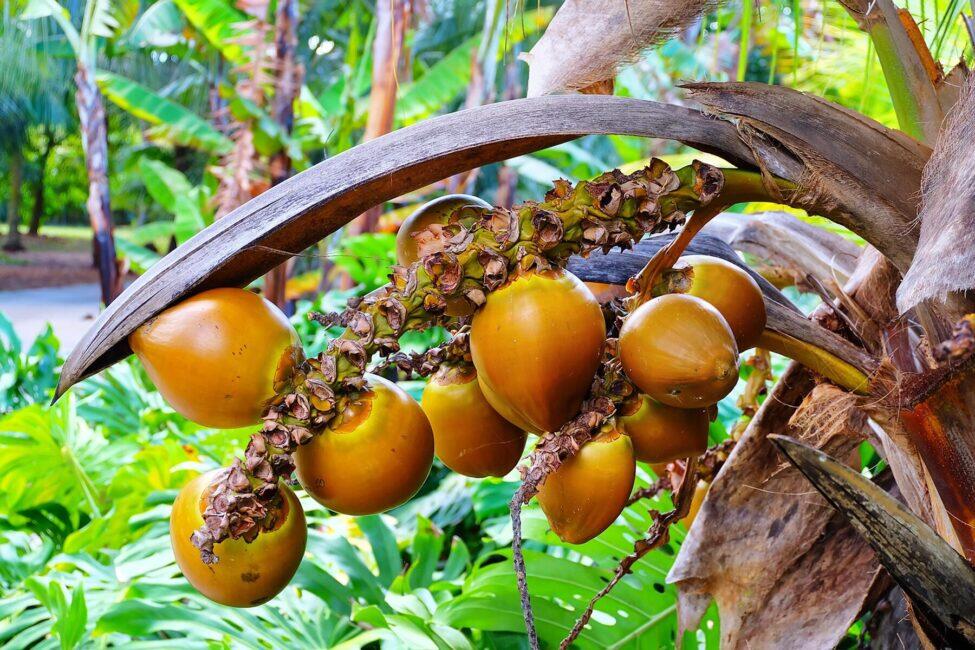A walk through this park gives you a taste of the world's produce.
As the tram slowed to a stop, we soon spotted what appeared to be neon green pickles hanging from trees in bunches. Below, a smattering of these curiosities lay strewn across the ground. With a friendly nudge from our guide, each of us picked one up, bit in, and puckered up as the sudden burst of sour tickled our taste buds.
At the Fruit & Spice Park, my family roamed the grounds of the tropical botanical garden situated roughly 35 miles south of Miami—between Biscayne and the Everglades. The 37-acre grounds contain more than 500 varieties of fruits, vegetables, nuts, herbs, spices, and other plants.
The best part? Visitors are encouraged to partake in the smorgasbord of fallen fruit while wandering the grounds, and for many, this invitation includes the joys of experiencing a food for the very first time. At one point, a romantic pair meandered by, offering up an enthusiastic preview of the candy-like substance we were about to experience for ourselves. After peeling away the outer shells of brown, oblong pods, we devoured the sticky sweet and sour pulp surrounding the seeds.
Like many of the fruits around us, my kids, wife, and I had never heard of bilimbis or tamarinds—much less tried them—before this memorable moment in time. These foods were fresh in more ways than one. And that, to us, was the real appeal.

A Tasty Trip Around the Equator
From the outset, our springtime adventure revolved around two of Florida’s national parks, with a day at the beach thrown in for good measure. The Florida sunshine and big-name destinations we’d had in mind from the get-go didn’t disappoint. We spotted majestic manatees in the waters of Biscayne National Park, paddled past a statuesque crocodile in the Everglades, and snorkeled with the fishes in John Pennekamp Coral Reef State Park.
Recommended Fodor’s Video
But to our surprise, the edible experience enjoyed on our way to these better-known hotspots emerged as one of our family’s favorite happenings of the entire journey.
The grounds at the Fruit & Spice Park are arranged into five subregions—Tropical Americas, Africa, Australia and the Pacific Islands, Asia, and the Mediterranean—allowing guests to “essentially travel around the equator,” said Park Manager Vanessa Trujillo. Several special collections are also sprinkled throughout, like a mango row that includes over 180 varieties. Although some species—like seagrape and pond apple—are native to the area, most of the trees, fruits, and vegetables grown at this garden come from other parts of the world.
INSIDER TIPNot all the plants are safe to eat, so when unsure, guests can ask a staff member for help or bring items back to the Welcome Center to learn more before taking the plunge and trying something new.
One of the beauties of this place is that there is always a different fruit in season or flower in bloom, Trujillo explained. In other words, “the experience is always different depending on the time of year that you come.”

How the Park Keeps Things Sweet and Spicy
What we saw—and savored—is the fruition of one woman’s foresight, according to a historical overview on the park’s website. And its full name, the Preston B. Bird & Mary Heinlein Fruit & Spice Park, harkens back to these formative days.
Captivated by the fruit and flora of the state’s southern region, Mary Calkins Heinlein sought to create a display of the area’s agricultural heritage. Her influence, coupled with the efforts of County Commissioner Preston B. Bird and Parks Director A.D. Barnes, led to the initial acquisition of land in 1943. Construction began the following year, and Heinlein went on to serve as the first superintendent.
These park visionaries wanted to showcase all the amazing fruits, vegetables, and herbs that can thrive in South Florida so that area residents could grow them at their own homes and share the harvest with their families, Trujillo explained.
Although Heinlein passed away nearly half a century ago, those early efforts live on as people come from near and far to gather a taste of the park and the wonders grown within—and potentially bring a little piece back home.
Those who fall in love with the taste of a new fruit, for example, or spot a plant they would enjoy adding to their backyard can consult with park staff to gather small cuttings or seeds. And those who are eager to learn more have the option of sampling an array of tours, classes, workshops, and festivals offered throughout the year.

The park’s mission is “expanding people’s understanding of their connection to the plant kingdom,” Trujillo said, which encompasses the past, present, and future. Every plant at the Fruit & Spice Park has a story, she explained, as well as a connection to people. That link between plant and people comes in the form of eating and tasting, to be sure, but it also comes in other ways, such as religious or structural significance. The Dade County Slash Pine was used to build pioneer homes long ago, for instance.
“Our staff are here to tell that story,” Trujillo added, “so that future generations know the importance of preserving and providing sustainability for many years to come.”




